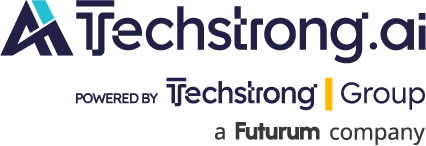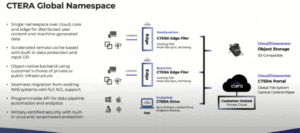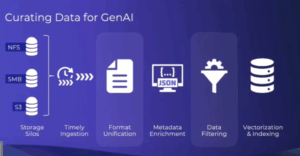
What does it take to transform fragmented data into a unified, intelligent asset? Many businesses find themselves sitting on mountains of information spread across different storage systems, locations, and formats. This data is messy, siloed, and difficult to manage, making it nearly impossible to use for advanced analytics or artificial intelligence. CTERA presented their vision for helping organizations move from storage-focused to leaders in enterprise intelligence at AI Infrastructure Field Day 3.
The Power of a Unified Namespace
The first step in this transformation is for organizations to consolidate their data estate and create a unified data layer. A unified namespace is the technology that makes this possible. It is a single, logical view of all your organization’s data, regardless of where it is physically stored.
This powerful capability eliminates data silos and simplifies management. The physical location is irrelevant to end users, the unified namespace presents it to users no matter where the data lives (if they have rights to access it, of course).
CTERA’s unified namespace creates a global data environment where information can be easily shared, analyzed, and protected.
Building a Unified Data Foundation for AI Workflows
When data is fragmented across different systems, geographies, and formats, making it difficult to unify and prepare for AI workflows. The unified namespace addresses this challenge by:
- Aggregating data from multiple sources into a single, cohesive system.
- Bridging the gap between disparate storage environments, such as legacy NAS systems, cloud storage, and edge devices.
- Enabling real-time synchronization and access, ensuring that data is always up-to-date and available for use.
Unlocking Enterprise Intelligence with CTERA
CTERA’s vision of enterprise intelligence involves more than just aggregating data. It involves unlocking the value of that data for AI, analytics, and decision-making.
Since the unified namespace provides a centralized view of data, it becomes easier to analyze and extract insights. A semantic layer is created by consolidating and organizing the data, which is necessary for advanced AI workflows like retrieval-augmented generation (RAG). The unified namespace also supports multi-protocol access (e.g., NFS, SMB, S3), ensuring compatibility with a wide range of AI and analytics tools.
Without the unified namespace, organizations would struggle to prepare their data for AI and analytics, as they would lack the infrastructure to unify and manage it effectively.
Is Your Data AI-Ready? Tackle These 3 Hurdles
According to a recent MIT study, a staggering 95% of GenAI pilot projects fail to deliver a return on investment. The reasons often boil down to fundamental data challenges. Let’s look at how CTERA’s platform, built on its unified namespace, addresses these issues head-on.
1. Conquer Messy, Unstructured Data
Organizations accumulate vast amounts of data over years, much of it outdated, irrelevant, or in unstructured formats like PDFs and videos. Feeding this “messy” data directly into an AI model is a recipe for disaster, leading to inaccurate and unreliable results.
CTERA’s platform helps you curate and enrich your data. By moving information into the unified namespace, the platform can:
- Classify and Tag Data: Automatically categorize files based on content, helping to separate valuable information from digital clutter.
- Enrich with Metadata: Extract key information from unstructured documents and add it as structured metadata. For example, it can identify the signing date and parties from a contract, making the document easily searchable and analyzable.
This process transforms your raw data into a high-quality, AI-ready asset, significantly improving the accuracy and relevance of your analytics.
2. Break Down Data Silos
Data silos are a major barrier to enterprise intelligence. When information is fragmented across different systems (e.g., SharePoint, Confluence, and various NAS devices) it’s nearly impossible to get a holistic view of the content.
The unified namespace dismantles these silos by creating a single source of truth. It aggregates data from all your disparate systems and geographies into one logical plane. This real-time synchronization ensures that everyone is working with the most current information, fostering better collaboration and decision-making.
3. Ensure Security and Compliance
For regulated industries like healthcare, finance, and defense, data security is non-negotiable. The thought of sensitive information being mishandled by an AI system is a significant concern.
CTERA’s platform is designed with security at its core. By managing data within the unified namespace, it can:
- Preserve Access Controls: Enforce existing permissions and ACLs (access control lists), ensuring that users and AI agents can only access data they are authorized to see.
- Implement Guardrails: Automatically redact sensitive information like Personally Identifiable Information (PII) during the ingestion process, adding a critical layer of protection.
- Provide Auditing: Offer comprehensive monitoring and auditing of all data access and modifications, which is essential for meeting compliance requirements.
From Data Chaos to Business Advantage
Think of the unified namespace as the foundation of everything CTERA does. It’s the key to tackling stubborn issues like data silos, messy or unstructured data, and strict compliance requirements. By bringing all your data into one organized layer, the unified namespace sets the stage for enterprise intelligence allowing teams can find, use, and trust their information, no matter where it lives.
But this approach isn’t just about storage. The unified namespace provides the sturdy framework needed for advanced AI workflows, like virtual employees and smart analytics, while keeping security top of mind. It’s the technology that turns scattered data into a business advantage.
To see these concepts in action, you can watch all of the CTERA presentations on the Tech Field Day website.



